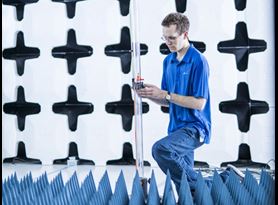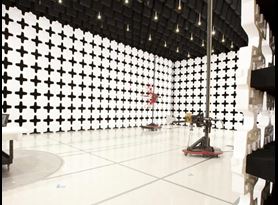Direct vs. Indirect Lightning Testing
Introduction
The Federal Aviation Administration (FAA) estimates that lightning hits a plane once every year. To prevent potential calamity, aircraft and their critical systems require stringent verification testing and certification plans that meet all the applicable standards and regulations.
Manufacturers must ensure that not only the aircraft frame but also its electronics, equipment, and critical components, such as fuel tanks, can withstand the effects of a lightning strike. In order to avoid catastrophic failures, it is imperative that they all continue to perform as expected.
Direct lightning strike testing is therefore a crucial part of aircraft design and qualification. This has become even more critical as a modern aircraft’s construction has progressed from aluminum to principally composite structures like carbon-fiber. In addition, mechanical controls and electromechanical instrumentation have been superseded by electronic avionics systems. Together, these changes in aviation design have increased the aircraft’s susceptibility to the effects of lightning, resulting in standards and regulations becoming increasingly rigorous.
The difference between direct and indirect lightning
Lightning can affect an aircraft and its systems through either direct or indirect lightning. A direct strike can cause physical damage from heat or shock, burning, and shattering materials from the high current associated with a lightning strike. If dielectric structures fail, such as Radomes and antennas, the lightning arc can directly attach to internal structure/cabling, potentially causing large currents to appear in critical systems.
The rapidly changing high currents associated with a lightning strike can induce currents and voltages in electrical systems due to electromagnetic coupling. For ground-based systems, even a nearby strike (indirect lightning) can affect electrical systems.
Using bespoke equipment, Element can recreate the currents associated with a direct lightning strike as well as replicate the induced currents/voltages, allowing either engineering or certification tests to be performed on aircraft or ground-based systems.
Lightning strike test standards and specifications
Regulations and test standards define procedures for the certification of aircraft structures and systems against lightning damage as well as defining the lightning characteristics to be considered.
The civil regulations set by the European Aviation Safety Agency (EASA) and the Federal Aviation Administration (FAA) in the USA give the basic requirements, whilst guidance documents on how such requirements can be achieved have been produced by the European Organization for Civil Aviation Equipment (EUROCAE) and the Society of Automobile Engineers (SAE) committees.
Together, these two committees continue to drive developments in the standards used. Element actively supports the EUROCAE working group looking at lightning standards, acting as secretary for the working group and task group leader for ED-105A/DO-160 Section 23.
Element’s aircraft lightning strike services cover a variety of commercial and defense specifications and are designed to meet the requirements of:
- RTCA DO-160 section 22
- RTCA DO-160 section 23
- ED-105/ARP5416
- MIL-STD-461
- DEF STAN 59-411
DO-160 sections 22 and 23 (ED-105/ARP5416) provide specific guidelines for testing the resilience of a unit of equipment against lightning effects. RTCA DO-160 section 23 focuses on lightning direct effects. The direct lightning strike on an aircraft also causes indirect voltage transients due to magnetic or electric field coupling and these indirect effects are covered specifically in section 22.
Accounting for potential faults and failures
Following an incident in 1996 in which a plane broke up in flight following a center fuel tank explosion, regulations for transport aircraft fuel tanks were modified. Designs are now required to incorporate a tolerance to anticipated wear and tear or installation faults. This has had a major effect on lightning test requirements, since the testing must cover not only the standard build, but also the possible fault/failure configurations that can arise during an aircraft’s lifespan. The manufacturer is required to anticipate and address the potential fault and failure conditions within the test program with a selection of worst-case test scenarios using different variables.
Simulating worst-case scenarios
When simulating lightning for testing purposes, a number of challenges must be carefully considered regarding how the tests are conducted, both in terms of the waveforms used and how the tests are carried out. Simulating the “worst-case” lightning threat using the most severe parameters needs to be combined with the provision of samples that are manageable enough to be tested, but whose results can be considered representative.
Lightning testing methods
Lightning testing is carried out by the reproduction of lightning and its effects under laboratory conditions. There are a variety of lightning strike test methods available, depending on the type of product being tested and the conditions being simulated.
Direct lightning testing methods
The two main methods for direct lightning testing are:
- High current testing where a lightning arc is created which can then replicate the effects of a lightning strike to an aircraft, both in terms of physical damage at the arc attachment location as well as looking at how the current distributes through the fuel system and critical structural elements.
- High voltage testing where the initial leader phase of a lightning strike, which can stress dielectric materials such as antennas, radomes and windscreens, is replicated.
Element’s specialist test facility in Abingdon is the only commercial laboratory in the UK with the capability to test aero-structures for the effects of direct lightning strikes (DO160/ED14 Section 23 testing), enabling time-to-market advantages through shorter testing turnaround times. The test chamber can accommodate sample sizes up to 3x3.5m, though larger samples can also be tested if required.
Indirect lightning testing methods
The two key methods for indirect lightning testing are:
- Pin injection testing where lightning transients are applied directly into the pins of electrical products and systems to determine if they cause any damage. This is one of the most common test methods for assessing the effects of an indirect strike.
- Cable bundle testing which is designed to evaluate how the effects of current flowing on cable screens and overbraids affects equipment. There are several types of cable bundle testing: single stroke, multiple stroke, and multiple burst. The single stroke method replicates the effect of the initial return stroke current on equipment while the multiple stroke method replicates the effects of successive lightning attachments to an aircraft in a short duration. Multiple burst testing is designed to replicate the effects of leaders stepping away from the aircraft which can cause upset to equipment.
The fully equipped lightning simulation laboratory also specializes in testing for indirect effects on electrical equipment and systems. Element tests for all waveform methods and protection levels per RTCA DO-160 Section 22. For projects with unique or custom requirements, Element has the ability to provide virtually any waveform transient, providing coverage for a wide range of products.
Electrostatic testing
- Electrostatic testing in which aircraft materials are tested to determine if accumulated charge poses a threat to fuel tanks. The increased use of composites in fuels tanks can lead to the accumulation of static.
- ESD testing in which the effects of charge accumulation on munitions due to handling (25kV), or from being carried by helicopter (300kV), are replicated.
Aircraft transient level testing (whole aircraft testing)
Critical avionic systems in aircraft need to be tested at an Equipment Transient Design Level (ETDL) which is aircraft/installation dependant. Full vehicle testing, at low current, determines the Actual Transient Level (ATL) which must be greater than the ETDL.
As part of its Design Support Services, Element is able to support the determination of the ETDL including via computational analysis. Element also supports all stages of full vehicle testing from test plan design through to data analysis.
Questions?
Element experts provide guidance and support for all stages of aircraft lightning protection design, testing, and certification. For more information about lightning strike testing, or to request a quote, contact us today.
Find related Resources
Get white papers, updates and event invites
Subscribe to content updates
Related Services

Indirect Lightning Testing
Complementing our HIRF and power quality tests, our indirect lightning testing services can provide virtually any waveform transient required for compliance.

EMC Testing Services
Find out how Element delivers electromagnetic compatibility testing (EMC) solutions to RTCA/DO-160, MIL-STD-461 and Def-Stan 59-411 standards.

Environmental Simulation
Find out how Element provides combined altitude, humidity, temperature and vibration test to simulate real-world environmental conditions for the Aerospace sector.

RTCA DO-160 Testing
Working with Element, our clients enjoy access to the most comprehensive EMC and environmental testing capacity of any independent Aerospace product qualification testing company in the world.
